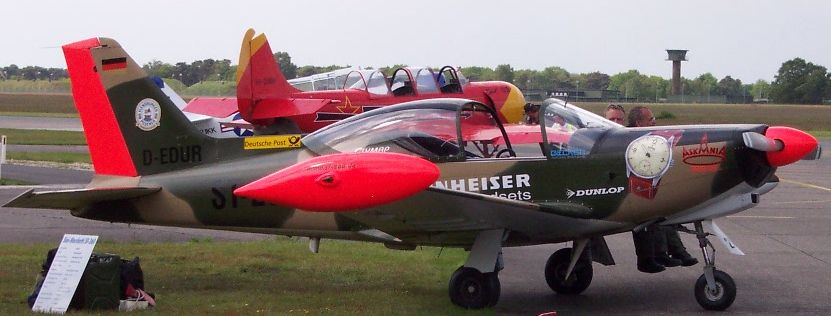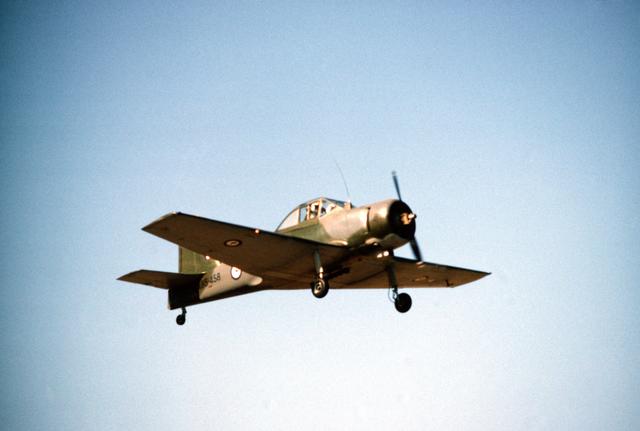|
Macchi M.B.323
The Macchi MB.323 was an Italian single-engine basic training monoplane designed and built by Macchi. No orders were placed and only a prototype was built. Design and development Designed as a basic trainer to complement the M.416 in Italian military service, the MB.323 first flew in 1952. It was a single-engine, low-wing cantilever monoplane powered by a nose-mounted Pratt & Whitney Wasp radial engine and a retractable tailwheel landing gear. It had two tandem cockpits covered by a sliding one-piece canopy. The type was evaluated against the Fiat G.49 which was preferred by the air force and the MB.323 did not enter production. Operators ; *Italian Air Force , colours = , colours_label = , march = (Ordinance March of the Air Force) by Alberto Di Miniello , mascot = , anniversaries = 28 March ... operated two aircraft for evaluation test Specifications See also ... [...More Info...] [...Related Items...] OR: [Wikipedia] [Google] [Baidu] |
WikiProject Aircraft
A WikiProject, or Wikiproject, is a Wikimedia movement affinity group for contributors with shared goals. WikiProjects are prevalent within the largest wiki, Wikipedia, and exist to varying degrees within sister projects such as Wiktionary, Wikiquote, Wikidata, and Wikisource. They also exist in different languages, and translation of articles is a form of their collaboration. During the COVID-19 pandemic, CBS News noted the role of Wikipedia's WikiProject Medicine in maintaining the accuracy of articles related to the disease. Another WikiProject that has drawn attention is WikiProject Women Scientists, which was profiled by '' Smithsonian'' for its efforts to improve coverage of women scientists which the profile noted had "helped increase the number of female scientists on Wikipedia from around 1,600 to over 5,000". On Wikipedia Some Wikipedia WikiProjects are substantial enough to engage in cooperative activities with outside organizations relevant to the field at issue. For e ... [...More Info...] [...Related Items...] OR: [Wikipedia] [Google] [Baidu] |
Italian Air Force
, colours = , colours_label = , march = (Ordinance March of the Air Force) by Alberto Di Miniello , mascot = , anniversaries = 28 March (Air Force Day) , equipment = , equipment_label = , battles = , decorations = , battle_honours = , battle_honours_label = , flying_hours = , website = , commander1 = Generale di squadra Luca Goretti , commander1_label = Chief of Staff of Air Force , notable_commanders = , identification_symbol = , identification_symbol_label = Roundel , identification_symbol_2 = , identification_symbol_2_label = Roundel Low Visibility , aircraft_attack = Panavia Tornado, AMX International AMX , aircraft_bomber ... [...More Info...] [...Related Items...] OR: [Wikipedia] [Google] [Baidu] |
Macchi Aircraft
Aermacchi was an Italian aircraft manufacturer. Formerly known as Aeronautica Macchi, the company was founded in 1912 by Giulio Macchi at Varese in north-western Lombardy as Nieuport-Macchi, to build Nieuport monoplanes under licence for the Italian military. With a factory located on the shores of Lake Varese, the firm originally manufactured a series of Nieuport designs, as well as seaplanes. After World War II, the company began producing motorcycles as a way to fill the post-war need for cheap, efficient transportation. The company later specialised in civil and military pilot training aircraft. In July 2003, Aermacchi was integrated into the Finmeccanica Group (now Leonardo) as Alenia Aermacchi, which increased its shareholding to 99%. Military trainers Since the beginning, the design and production of military trainers have been the core business of Alenia Aermacchi. The products include: * SF-260, piston-engined or turboprop-powered screener/primary trainer * MB- ... [...More Info...] [...Related Items...] OR: [Wikipedia] [Google] [Baidu] |
1950s Italian Military Trainer Aircraft
Year 195 ( CXCV) was a common year starting on Wednesday (link will display the full calendar) of the Julian calendar. At the time, it was known as the Year of the Consulship of Scrapula and Clemens (or, less frequently, year 948 '' Ab urbe condita''). The denomination 195 for this year has been used since the early medieval period, when the Anno Domini calendar era became the prevalent method in Europe for naming years. Events By place Roman Empire * Emperor Septimius Severus has the Roman Senate deify the previous emperor Commodus, in an attempt to gain favor with the family of Marcus Aurelius. * King Vologases V and other eastern princes support the claims of Pescennius Niger. The Roman province of Mesopotamia rises in revolt with Parthian support. Severus marches to Mesopotamia to battle the Parthians. * The Roman province of Syria is divided and the role of Antioch is diminished. The Romans annexed the Syrian cities of Edessa and Nisibis. Severus re-establish his ... [...More Info...] [...Related Items...] OR: [Wikipedia] [Google] [Baidu] |
Illustrated Encyclopedia Of Aircraft
The ''Illustrated Encyclopedia of Aircraft'' was a weekly partwork magazine by Aerospace Publishing (an imprint of Orbis Publishing) which was published in the United Kingdom (and sold in other countries too) during the early 1980s. The magazine was intended to eventually make up a multi-volume encyclopedia dedicated to aviation. First issued in 1981, the partwork comprised 216 issues, each of twenty pages (plus the covers), making up eighteen volumes (4280 pages). The first two issues were sold together for the price of one, subsequent issues were sold on their own. Empty binders for each volume (of twelve issues) were also sold. These binders were dark blue in colour and contained the imprint of a Panavia Tornado on the front. They held the issues using a metal strip that was threaded through the staples of each issue to hold them in place. Each issue consisted of four separate sections. The final two parts (215 and 216), issued in 1985, comprised the index for the encyclopedi ... [...More Info...] [...Related Items...] OR: [Wikipedia] [Google] [Baidu] |
Yakovlev Yak-11
The Yakovlev Yak-11 (russian: Яковлев Як-11; NATO reporting name: "Moose") is a trainer aircraft used by the Soviet Air Force and other Soviet-influenced air forces from 1947 until 1962. Design and development The Yakovlev design bureau began work on an advanced trainer based on the Yak-3 fighter in mid-1944, although the trainer was of low priority owing to the ongoing Second World War.Gunston 1995, p. 469. The first prototype of the new trainer, designated Yak-UTI or Yak-3UTI flew in late 1945. It was based on the radial-powered Yak-3U, but with the new Shvetsov ASh-21 seven-cylinder radial replacing the ASh-82 of the Yak-3U.Gordon Komissarov and Komissarov 2005, p. 249. It used the same all-metal wings as the Yak-3U, with a fuselage of mixed metal and wood construction. The pilot and observer sat in tandem under a long canopy with separate sliding hoods. A single synchronised UBS 12.7 mm machine gun and wing racks for two 100 kg (220 lb) bombs compris ... [...More Info...] [...Related Items...] OR: [Wikipedia] [Google] [Baidu] |
Valmet Vihuri
Valmet Vihuri (Finnish for ''Gale'') was a Finnish advanced two-seat fighter trainer aircraft, serving in the Finnish Air Force between 1953 and 1959. Only a few airframes have survived, as in the Central Finland Aviation Museum in Finland. History In spite of their economic problems, the aircraft manufacturer Valmet began designing a new aircraft at the beginning of the 1950s, to replace the aging Finnish Air Force (FAF) VL Pyrys. Martti Vainio was the chief designer of the project. Most of the planning was made by the aeronautical engineers L. Hämäläinen and T. Mäntysalo in 1948–49. The Bristol Mercury, then being manufactured under license in Finland for the Bristol Blenheim bomber, was chosen as the engine, since it was readily available. The prototype (VH-1) made its first flight on 6 February 1951, in Tampere, piloted by captain Esko Halme. After successful test flights, the FAF ordered 30 production aircraft, called Valmet Vihuri II, on 27 February 1951. In the autum ... [...More Info...] [...Related Items...] OR: [Wikipedia] [Google] [Baidu] |
Piaggio P
Piaggio & C. SpA (Piaggio ) is an Italian motor vehicle manufacturer, which produces a range of two-wheeled motor vehicles and compact commercial vehicles under seven brands: Piaggio, Vespa, Gilera, Aprilia, Moto Guzzi, Derbi, and Scarabeo. Its corporate headquarters are located in Pontedera, Italy. The company was founded by Rinaldo Piaggio in 1884, initially producing locomotives and railway carriages. Piaggio's subsidiaries employ a total of 7,053 employees and produced a total of 519,700 vehicles in 2014. The manufacturer has six research-and-development centers and operates in over 50 countries. History In 1882, Enrico Piaggio purchased land in Sestri Ponente (Genoa) to set up a timber yard. Two years later, in 1884, his 20-year-old son, Rinaldo Piaggio (1864–1938), founded Piaggio & C. The company initially built locomotives and railway carriages but in 1917, towards the end of World War I, Rinaldo Piaggio turned to the military sector. To begin, the company produced ... [...More Info...] [...Related Items...] OR: [Wikipedia] [Google] [Baidu] |
Percival Provost
The Percival P.56 Provost is a basic trainer aircraft that was designed and manufactured by British aviation company Percival. During the 1950s, the Provost was developed for the Royal Air Force (RAF) as a replacement for the Percival Prentice. Designed by Henry Millicer, it was a single-engined low-wing monoplane, furnished with a fixed, tailwheel undercarriage and, like the preceding Prentice, had a side-by-side seating arrangement. First flying on 24 February 1950, the prototypes participated in an official evaluation, after which the type was selected to meet Air Ministry specification T.16/48. The Provost entered service with the RAF during 1953 and quickly proved to be more capable than the preceding Prentice. It was a relatively successful aircraft, being exported for multiple overseas operators. Various models were developed, both armed and unarmed, to meet with customer demands. The Provost later adapted to make use of a turbojet engine, producing the BAC Jet Provost. ... [...More Info...] [...Related Items...] OR: [Wikipedia] [Google] [Baidu] |
CAC Winjeel
The CAC CA-25 Winjeel is an Australian-designed and manufactured three-seat training aircraft. Entering service with the Royal Australian Air Force (RAAF) in 1955 as a basic to advanced trainer, it served in this role until 1975. Later, it was used in the Forward Air Control (FAC) role for target marking until 1994, after which it was retired from RAAF service. Design and development The Winjeel (from a Victorian indigenous word for "young eagle", an alternate spelling of Bunjil) was developed by the Commonwealth Aircraft Corporation at Fishermans Bend in Victoria to satisfy RAAF technical requirement No.AC.77 issued in 1948. Designed to replace both the Tiger Moth and the CAC Wirraway, the first two prototype CA-22 aircraft were flown in February 1951. However, it proved a very stable aircraft making it almost impossible to spin, and with this being a required part of pilot training the tail had to be redesigned as a result. Sixty-two production CA-25 aircraft were subsequently ... [...More Info...] [...Related Items...] OR: [Wikipedia] [Google] [Baidu] |
Machine Gun
A machine gun is a fully automatic, rifled autoloading firearm designed for sustained direct fire with rifle cartridges. Other automatic firearms such as automatic shotguns and automatic rifles (including assault rifles and battle rifles) are typically designed more for firing short bursts rather than continuous firepower, and are not considered true machine guns. As a class of military kinetic projectile weapon, machine guns are designed to be mainly used as infantry support weapons and generally used when attached to a bipod or tripod, a fixed mount or a heavy weapons platform for stability against recoils. Many machine guns also use belt feeding and open bolt operation, features not normally found on other infantry firearms. Machine guns can be further categorized as light machine guns, medium machine guns, heavy machine guns, general purpose machine guns and squad automatic weapons. Similar automatic firearms of caliber or more are classified as autocannons, rat ... [...More Info...] [...Related Items...] OR: [Wikipedia] [Google] [Baidu] |

.jpg)



